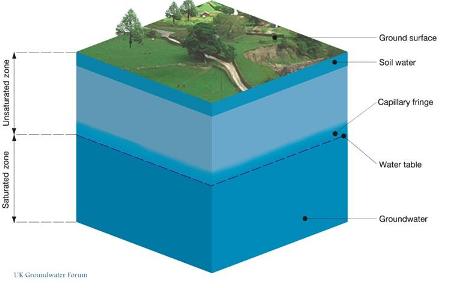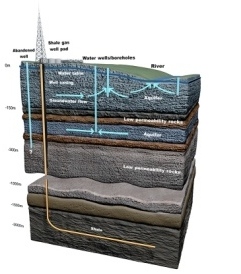Groundwater and shale gas: background information
What is groundwater?
Groundwater is part of the water cycle and consists of water that has filtered into the ground from rainfall, snowmelt and rivers. It forms the largest available store of freshwater in the UK, far in excess of river or lake waters. Over lowland England, about half of all freshwater supplies come from groundwater and in parts of the south east this rises to more than 70 per cent. About three quarters of all groundwater taken is used for public water supply, with the remainder being used for agricultural, industrial and other purposes. One reason for this is that, compared with surface waters, groundwater is relatively high quality and requires less treatment prior to use. Groundwater also provides flow to many rivers and wetlands and so sustains a wide range of ecosystems.
Find out more about groundwater and our research elsewhere on our site. In addition, an excellent introduction to groundwater can be found on the Groundwater Forum website.
How is groundwater managed and protected in the UK?
In England, the Environment Agency (EA) has a duty to manage the use of groundwater. They do this by balancing the needs of water companies to supply water to consumers with the need to preserve the environment, protect it from pollution and over-abstraction, and where it is already polluted ensure that it is cleaned up. Natural Resources Wales (NRW) and Scottish Environment Protection Agency (SEPA) have similar responsibilities for Wales and Scotland.
Detailed information about how the EA manages groundwater in England is set out in the report Groundwater Protection: Principles and Practice (GP3).
More information on how Natural Resources Wales and the Scottish Environment Protection Agency manage and regulate groundwater in Wales and Scotland can be found on their websites.
What is shale gas?
Shale gas is natural gas trapped in shales and clays, which are fine-grained, sedimentary rocks predominantly comprised of consolidated clay sized particles that were originally deposited as muds. It is the decay of organic matter, in the form of algae, plant and animal derived organic debris that was deposited along with the very fine-grained sediments, that is the source of the shale gas. The gas is produced from the breakdown of organic material as the muddy sediments are buried, pressurised and heated and turned into shale rocks. The formation of the gas typically requires burial of shales to depths of a kilometre or more and many potential shale gas source rocks are found at those depths.
Consequently, the shale is both the source and the reservoir for the natural gas, which is predominantly methane (approximately 90 per cent) but may also contain other hydrocarbons, carbon dioxide, nitrogen, hydrogen sulphide and rare gases. The gas is held in natural fractures and pore spaces or adsorbed onto the organic material and minerals in the shale.
How is shale gas extracted?
It is technically challenging to obtain shale gas because it is bound to rocks at great depth. Unlike conventional drilling for hydrocarbons, drilling for shale gas combines horizontal drilling with hydraulic fracturing ("fracking"). Horizontal drilling, sometimes to more than 1500 m away from the vertical wellbore, greatly increases the length of contact between the shale gas formation and the wellbore relative to a conventional vertical well, and hydraulic fracturing releases shale gas to enable it to be retrieved in commercially viable quantities.
Find out more
The environmental implications of shale gas development in the UK is a rapidly developing area of research. If you would like to know more about this topic, including the implications for groundwater, the following sources of information may be helpful.
- Other content on the BGS website, including frequently asked questions about shale gas and groundwater and an overview of naturally occurring methane in UK groundwater.
- BGS report on potential groundwater impact from exploitation of shale gas in the UK.
- The Department of Energy & Climate Change report Fracking UK shale: water.
- The Royal Society report on shale gas extraction.
- The Tyndall Centre assessment on the impact of shale gas development on climate change and the environment.
- The Public Health England draft report on risks to public health from exposure to emissions from shale gas extraction.
To find out more about environmental policy and regulation related to aquifers and shales in the UK visit the following sites:
Contact
Please contact BGS Enquiries for more information.










